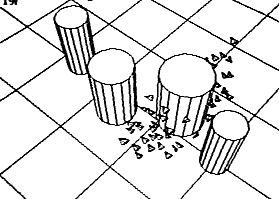In 1986 I made a computer model of coordinated animal motion such as
bird
flocks and fish schools. It was based on three dimensional
computational
geometry of the sort normally used in computer animation or computer
aided
design. I called the generic simulated flocking creatures
boids.
The basic flocking model consists of three simple
steering behaviors which describe how an
individual
boid maneuvers based on the positions and velocities its nearby
flockmates:
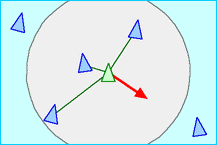 |
|
Separation: steer to avoid crowding
local flockmates |
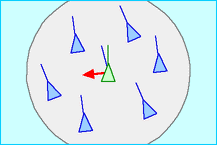 |
|
Alignment: steer towards the average
heading of local flockmates |
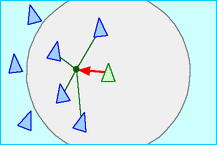 |
|
Cohesion: steer to move toward the
average position of local flockmates |
Each boid has direct access to the whole scene's geometric description,
but
flocking requires that it reacts only to flockmates within a certain
small
neighborhood around itself. The neighborhood is characterized by a
distance (measured from the center of the boid) and an angle,
measured from the boid's direction of flight. Flockmates outside this
local
neighborhood are ignored. The neighborhood could be considered a model
of
limited perception (as by fish in murky water) but it is probably more
correct
to think of it as defining the region in which flockmates influence a
boids
steering.
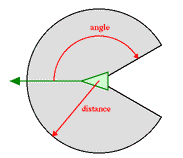
a boid's neighborhood
A slightly more elaborate behavioral model was used in the early
experiments.
It included predictive obstacle avoidance and goal seeking. Obstacle
avoidance allowed the boids to fly through simulated environments while
dodging static objects. For applications in computer animation, a low
priority goal seeking behavior caused the flock to follow a scripted
path.
In cooperation with many coworkers at the Symbolics Graphics Division
and
Whitney / Demos Productions, we made an animated short featuring the
boids
model called Stanley and Stella in: Breaking the Ice. This film
was first shown at the Electronic Theater at SIGGRAPH '87. There was a
technical paper on boids
published at
the same conference. In the course notes for SIGGRAPH '88 there was an
informal paper about obstacle avoidance.
Since 1987 there have been many other applications of the boids model
in the
realm of behavioral animation. The 1992
Tim
Burton film
Batman Returns was the first. It contained computer simulated bat
swarms
and penguin flocks which were created with modified versions of the
original
boids software developed at Symbolics.
Andy Kopra
(then at VIFX, which later merged with
Rhythm & Hues)
produced realistic
imagery of bat swarms. Andrea Losch (then at Boss Films) and Paul
Ashdown
created animation of an "army" of penguins marching through the streets
of
Gotham City.
As luck would have it, Chris Langton
organized the original ground-breaking
Artificial Life Workshop a few months after the boids paper was
published
in 1987. A helpful go-between got word to Chris and he let me give an
informal presentation on boids at the
Workshop. The
boids
model has become an oft-cited example of principles of Artificial
Life. Flocking is a particularly evocative example of emergence:
where
complex global behavior can arise from the interaction of simple local
rules.
In the boids model (and related systems like the multi-agent
steering behavior demos) interaction
between
simple behaviors of individuals produce complex yet organized group
behavior.
The component behaviors are inherently nonlinear, so mixing them gives
the
emergent group dynamics a chaotic aspect. At the same time, the
negative
feedback provided by the behavioral controllers tends to keep the group
dynamics ordered. The result is life-like group behavior.
A significant property of life-like behavior is unpredictability
over
moderate time scales. For example at one moment, the boids in the
applet
above might be flying primarily from left to right. It would be all but
impossible to predict which direction they will be moving (say) five
minutes
later. At very short time scales the motion is quite predictable: one
second
from now a boid will be traveling in approximately the same direction.
This
property is unique to complex systems and contrasts with both chaotic
behavior (which has neither short nor long term predictability) and
ordered
(static or periodic) behavior. This fits with Langton's
1990
observation that life-like phenomena exist poised at the edge of
chaos.
The boids model is an example of an individual-based
model, a class of simulation used to capture the global behavior of
a
large number of interacting autonomous agents. Individual-based models
are
being used in biology, ecology, economics and other fields of study.
Note that the straightforward implementation of the boids algorithm has
an
asymptotic complexity of O(n2). Each boid
needs to
consider each other boid, if only to determine if it is not a nearby
flockmate. However it is possible to reduce this cost down to
nearly O(n)
by the use of a suitable spatial data structure which allows
the boids
to be kept sorted by their location. Finding the nearby flockmates of a
given
boid then requires examining only the portion of the flock which is
within the
general vicinity. Using such algorithmic speed-ups and modern fast
hardware,
large flocks can be simulated in real time, allowing for interactive applications.
[new]
Online resources related to boids
Other computational models of group motion
- Computer animation
- Eurythmy by Susan Amkraut and Michael Girard contained
the first procedural animation of flocks when it was shown at the Film
& Video Show of SIGGRAPH '85. It is available on SIGGRAPH Video
review
(SVR Issue 21, Entry 2). Some imagery from the final version
appear on this page from Ars Electronica 89. Amkraut and
Girard also created flocking and herding in the 1993 VR production
Menagerie.
- Jessica
Hodgins and colleagues at Georgia Tech's GVU have created several
physically-based models of
group behaviors such as herding one-legged hoppers and a pack of
bicyclists.
- Disney's The
Lion King (1994) included a wildebeest stampede by Kiran Joshi,
MJ Turner, et al.. Here are two stampede-related items from Brian Tiemann's excellent
The Lion King WWW Archive:
- Xiaoyuan
Tu implemented a realistic, physically-based model of fish
schooling as part of her dissertation research on artificial animals.
See also:
- While at Santa Barbara Studios, Mark Wendell used the Dynamation
particle system software to create animation of flocking space
creatures for Elogium
an episode of Star Trek: Voyager.
- Course CS206
at George Washington University includes an assignment to implement a Behavioral
Motion Control System like boids. You can see some of the
student's animations from:
1997,
1998 and 1999.
[new]
- Games, Interactive graphics and virtual reality
- Rip-Off
(1980) a video
arcade game designed by Tim
Skelly featured a group of three autonomous "enemy tanks" which
exhibited coordinated
group motion. They avoided collisions with each other and would seek
the goal
objects ("canisters"), or if they got too close, the player controlled
vehicles. The combination of goal seeking and collision avoidance
produced a
motion like flocking. For more details, read Tim Skelly's own description of the behavior.
See also this
Rip-Off screenshot
and this page about an
emulator. [new]
- Plasm:
A Fish
Sample (1985) by PeterBroadwell
, Rob Myers, Robin
Schaufler, Eva Manolis, et
al., premiered
at the SIGGRAPH 85 art show. On at least one occasion, a school
accidentally
arose in this "virtual fish tank".
- Parallel
Bird Flocking Simulation (1993) by
Helmut Lorek and Matthew White. Describes an implementation of
boids using up to 50 parallel Transputer processors to simulate flocks
of up to 100 boids at interactive rates (6 frames per second or
better). The simulation included obstacle avoidance. The full article
is available in PDF.
[new]
- The Virtual Fishtank
introduces visitors to the sciences of complexity, artificial life and
related fields. It is an online version of a project that started as an
installation
at The Computer Museum
in Boston. Its goal is to introduce visitors to the sciences of
complexity and artificial life. The original project was jointly
developed by the MIT Media Lab
(see their
project page) and NearLife Inc.
(see their recent
projects page).
- Virtual
Great Barrier Reef: A theoretical approach towards an evolving,
interactive VR environment using a distributed DOME and CAVE System
(1998) by Scot Thrane Refsland,
Takeo Ojika, Tom Defanti, Andy Johnson, Jason Leigh, Carl Loeffler, and Xiaoyuan Tu in
Proceedings of Virtual Worlds '98. Paris, France, July 1-3, 1998. Also
available in
PDF.
- Robotics
- Maja Mataric
heads The Interaction
Lab at the University of Southern California which studies robotic group behaviors.
See also Maja's
dissertation and these videos of robots
performing various group behaviors, including flocking. (Some
press clippings from
WIRED and CNN.
And see this delightful
story about Maja (the second paragraph))
- Cooperative
Mobile Robotics: Antecedents and Directions by Y. Uny
Cao, Alex S. Fukunaga, and Andrew B. Kahng (UCLA 1996) surveys research
in robot groups.
- The
Robot Sheepdog Project by Richard Vaughan et
al. provides an interesting contrast to much of the work cited on
this page: the flocking/herding involved is of natural animals while a
robot plays a role similar to a sheepdog. As is done when training real
sheepdogs, ducks are used here as a less challenging stand-in for
sheep. Read the delightful
paper for more detail. See also Neil Sumpter's pages
about the vision
research related to robo-sheepdog.
- The
Examination and Exploration of Algorithms and Complex Behaviour to
Realistically Control Multiple Mobile Robots (1997) by Duncan Crombie,
examines algorithms to control multiple mobile robots, focuses on
behaviors that can be obtained through local control, and demonstrates
createing complex behaviours with simple algorithms. [new]
- Self-Organization
in Large Populations of Mobile Robots (1993) by Cem Ünsal Describes
the use of a homogeneous population of robots, an Army-ant swarm,
for transportation of material. Investigates both spatial and
behaviroal self-organization. [new]
- Social
Behavior in The Ants
a community of cubic-inch microrobots which form a
structured robotic community capable of task such as clustering,
following the leader, and playing tag. [new]
- Distributed
Ant Robotics a collection of publication and resources
by Israel
Wagner [new]
- Collective
Locomotion (1998) by Pierre
Arnaud of the LAMI
Collective Robotics Group. Includes papers and Labot,
a Java demonstation applet. [new]
- Calculating
Swarms (2000) by Ivars Peterson
(in Science News)
discusses swarm intelligence, emergent computation and collective
robotics. [new]
- Aerospace (coordinated groups of aircraft or spacecraft)
- Education (about distributed and complex systems)
- Artificial life and Evolutionary computation
- Art
- Biology
- Physics
- Tamás Vicsek
published an analysis of flocking particles in Physical Review Letters
on August 7, 1995, which focused on transitions in collective behavior.
(I will provide a more complete description here when I better
understand Prof. Vicsek's work.)
- J Dana
Eckart implemented a cellular automata model of
flocking using his Cellular
system based on Vicsek's
work.
- Work
by Yu-hai Tu and John Toner
published in Physical Review Letters (Volume 75, page 4326, December 4,
1995) includes a proof that motion of a flock or herd is essential to
its collective ability to align. That is, group alignment is not
possible with local perception in the absence of motion.
- Surprises
in Nonequilibrium Critical Phenomena: From Flocking Dynamics to
Chemical Reactions (0.7 MB gzipped Postscript) by Yu-hai Tu presented at the 1996
Santa
Fe Workshop on Nonequilibrium Phase Transitions.
- Flocks,
Herds, and Schools: A quantitative theory of flocking by Toner and Tu in Physical Review E,
October 1998, Volume 58, Issue 4, pp. 4828-4858. See the AIP summary: Birds
of a Feather: The Physics of Flocks, this summary from
Academic Press, and this article from
Newsweek.
- Physics of Flocks (Part 1
and Part
2) by Karl Kruszelnicki,
transcripts and audio recordings from Great
Moments in Science on the Australian Broadcasting Corporation.
- Search, optimization and visualization techniques inspired by
flocks and swarms
- Particle
Swarm Optimization (and see the original 1995
PSO paper by James
Kennedy and Russ
Eberhart) searchs a multidimensional solution space. Somewhat like
a genetic algorithm, but the PSO's search points move as a swarm
through the space with a velocity, altered by steering accelerations.
See also this PSO demo
applet.
- The
use of Flocks to drive a Geographic Analysis Machine (1998) by James
Macgill and
Stan Openshaw, uses a flock model, with communication between
boids, to better search for clusters in spacial datasets, just as a
natural flock provides better foraging than individual birds could
manage. See this demo applet.
- Ant
Colony Optimization introduced in 1992 by Marco Dorigo
"...studies artificial systems that take inspiration from the behavior
of real ant
colonies and which are used to solve function or combinatorial
optimization problems..."
- Information
Retrieval in the World-Wide Web: Making Client-based searching feasible
(1994) by Paul
De Bra and Reinier Post,
uses a school of fish metaphor to search the web.
- Information
Flocking by Glenn Proctor is a data visualization
technique that portrays datapoints as fish that school
through a 3d space, revealing correlations in the data by their motion
and clustering. See the paper Information
Flocking: Data Visualisation in Shared Worlds Using Emergent Behaviours
(1998, PDF 91KB) by Glenn Proctor and Chris Winter. [new]
- Ant-based
Load Balancing in Telecommunications Networks (1996) by Ruud
Schoonderwoerd, Owen Holland.
Janet
Bruten and
Leon Rothkrantz. See also these related links: There's
an ant in my phone (1998) by Mark Ward in New Scientist,
British Telecom: Notes from the Ant Colony (1997) by Julia Flynn in
BusinessWeek, and Collective
Intelligence for Network Control. [new]
- Other emergent, collective behavior
- Amorphous
Computing HomePage a research group exploring the question: "How do
we obtain coherent behavior from the cooperation of large numbers of
unreliable parts that are interconnected in unknown, irregular, and
time-varying ways?" [new]
- Swarm
Intelligence:
Payman Arabshahi's
page of links on emergent computation by swarms of simple agents. [new]
- Other topics...
- John
Mee's term report on software to simulate the
movement of a flock of birds.
- G.
Keith Still has developed a system called
Legion to simulate the motion of large crowds of people. It can
handle crowds of more than 100,000 people. See also these
related pages, and these articles by Sheryl Canter in PC Magazine from April 1996
and May
1996.
- A page of Java-based
demos by the Biological Model Simulation group at Keio University.
The demos are in 2d and include basic schooling, predation, interactive
feeding, and schooling with two species.
- Animation Science Corporation
sells tools to model the motion of large crowds with their Rampage
software, based on an efficient engine for interacting particle
systems.
- Daniel Bullok wrote a fishtank simulation as
a class project.
- An introduction called Complexity and
Social Behaviour and a computational model of resource-deprived termites by
Octavio Miramontes
- A
Flocking-Strategy for a programmable multi-agent shell VehicleGuide
by Jan Beutler
- Jonathan
Robbins' page
The Boids is the report from his Science Project -- his 8th
grade Science Project, mind you. (Yikes! Kids these days!)
- Simulation
of Herding with Dynamics by Howard
Zhang uses a simple spring-mass model of animal bodies and
simulates herding on the plane. This report contains good diagrams and
descriptions of the implementation of component steering behaviors.
- The
Computational Beauty of Nature is the web site for a book of the
same name by Gary W. Flake
(shop for the book
here). He implemented boids and added another rule which cause the
boids to attempt to maintain a clear view ahead of them. This resulted
in flocks which form the classic "V" formations of migrating geese. See
the Java
demonstration.
- In a class project called
A-Life Foodchain Simulation Leon Blackwell extends a boid-like
model to include predator-prey interactions.
- The
Duck Pond: Following, Flocking and Herding a 1977 class project by
Brian O'Connor. Includes source code and animations. (Although
there seem to be access problems for some of the files.)
-
E Pluribus Unum (the January 1999 installment of Brian Hayes'
column on Computing Science in American Scientist)
talks about emergence using examples such as flocks, schools,
herds, traffic jams, ant colonies, and forest fires.
- An
attempt to replicate the main findings of Craig Reynolds's (1987)
'Boids' by Harry Brignull, reports on a project to implement boids
using the
POPBUGS package by Chris Thornton.
Includes diagrams of the resulting group motion and source code.
- Flocking,
Boids and Tag (1998) by Aron
Helser. This class
project involved an interactive flock which plays the game of tag and
allows the use to either ride along passively with a member of the
flock, or take control and pilot the boid. [new]
- GOIDS
Project a study of flocking geese objects (1999) by Cathryn J
Polinsky. Presentation slides for a Senior Project called "Flight
Simulation of Flocking Geese Using Particle Set Animation" [new]
Natural flocks, herds, and schools
- Some seminal papers from the (hardcopy) literature:
- The Structure and Function of Fish Schools (1982) by
Brian Partridge in Scientific American,
June 1982, pages 114-123.
- The Chorus Line Hypothesis of Manoeuvre Coordination in
Avian Flocks (1984) by
Wayne Potts, in Nature,
Volume 309, May 24, 1984, pages 344-345.
- Animal Groups in Three Dimensions: How Species Aggregate
(1997) edited by
Julia K. Parrish and William M. Hamner. A collection of papers
related to a 1991 workshop on measuring and modeling animal
aggregations. Use this link to
shop for the book.
- A 22 second movie of a
school of anchovies (160x120 pixels, in JPEG
(1.1 Mb) and Quicktime
(1.8 Mb) formats) swimming in the Kelp Forest tank at the Monterey Bay Aquarium from a page of
fish videos at
FINS. See also the live Kelp Cam view of
this tank.
- Here are some other flock/herd/school pictures on the web: schooling
anchovies, school
from below, crowded
fish, orca
and herring, herd of
running Akhalteke, school
of spadefish,
Gallimimuses flock (Jurassic Park),
V formation of geese, herd
of wild asses, wildebeest
herd, herring
schooling (MPEG, 0.5 Mb), herring
school turning (MPEG, 1.0 Mb) ...
- Temple Grandin's interesting
site on behavior of livestock and other subjects, contains a section on
Recommended Basic Livestock Handling which covers topics such as:
each of which contain pictures and diagrams on geometrical
relationships between herds of livestock, the shapes of their
enclosures, and the positions of human handlers.
- William H. Calvin's book The Ascent of Mind
discusses the predation on herds of early humans in Chapter 8: Hand-Ax Heaven (you
may wish to search for the first occurance of herd).
- Lessons from
Geese: on the structure of migratory goose flocks, and folksy
thoughts on applying these ideas to groups of humans.
- V formations: at the bottom of Jim Rible's page about the Canada
Goose there is a discussion about the mixed evidence for an
aerodynamic explanation of the "V" formations often seen in migrating
ducks and geese. See also the cited references.
- A page by Uwe
Kils illustrating how individual fish in a school benefit from
reduced predation due to optical confusion.
- An essay called Migration
Advantages of Shoaling by Tony J. Pritcher in his book
Behaviour of Teleost Fishes describes research by Uwe Kils into the
effect he calls synchrokinesis whereby small movements of
individuals copied through the shoal provide an accurate movement
towards better conditions. (Contrast this with the work of Toner
and Tu (above) which suggests that individual errors are damped out
by interaction with the rest of the group.)
- Vigilance,
Flock Size, and Flock Geometry: Information Gathering by
Western Evening Grosbeaks (1995) by Marc
Bekoff a field ethology study of how the size and relative
positioning of this bird affect the vigilance (scanning) behavior of
individuals in the group. [new]
- Cutting horses and herding dogs: these two types
of trained animal behaviors have evolved into modern sport
competitions. Their origin was to assist humans raising stock animals,
and they can still be found in this role today. Both are related to
herding behavior in special ways.
- The job of a herding dog (stockdog, sheepdog) is to help a
shepherd contain and control a herd of stock animals (especially sheep,
goats or cattle). A herding dog uses its understanding of the stock
animal's herding behavior to be able to move the whole group as a unit.
For more information see: The
Stockdog Server, Dog-Play:
Herding and The
Herding Page [new]
- The cutting horse derived from the American cowboy culture
and is specifically trained to handle cattle. A cutting horse's skill
is in being able to defeat the cattle's herding instinct,
allowing it to separate off (cut) one individual at a time. The site of
the National Cutting Horse
Association includes history
and videos of
the sport. [new]
- Some general information about these animals:
Software
(There is additional source code for Java implementations listed on the
boids applet page.)
- Boids
- This is the original 1986-1988 implementation, written in
Symbolics Common Lisp, and based on Symbolics' S-Geometry 3d modeling
system and S-Dynamics animation system. (Modern versions of
those applications are available from Winged Edge Technologies, see:
Mirai Modeling and
Mirai Animation. Your browser may not recognize this file as Lisp
source code and try to reformat it as filled text. If so use [View /
Page Source] or equivalent, or download the file.)
- C++
Boids
- This platform-independent boids implementation by Christopher Kline
includes C++ source code and an Inventor-based binary executable demo
for SGI machines. These boids support both flocking and obstacle
avoidance.
- Buzzz!
- An After Dark screen saver module for Macintosh computers
by Simon Fraser. This
very nice package implements a parameterized version of boids including
several species of creatures (wasps, birds, fish, sheep...) based on
altering the parameters. There are control panels that allow you to
experiment with the parameters. For other sources of this software see
Simon's AD page.
- boids.exe
- by
Jürgen Schmitz. Version 1.0 of a Windows application featuring
three distinct species of flocking birds and nice control panels for
adjusting their parameters. See the
readme file for more information.
- SchoolView
- This is a screen saver for NeXT computers by David Lambert based on the
boids model. C code and related files are available for FTP. See the
readme file for details.
- A-Quarium
- A screen saver for Windows by Ric Colasanti. A-Quarium
is a fish tank simulator somewhat related to boids. "...a fish will try
to swim with a close neighbour if it is of the same species, and will
try to swim away if it is of a different species. The behaviour of the
fish tank is an emergent property of all the individual fish
actions..."
- Max
Boids
- There is an implementation of boids for MAX,
an interactive real-time graphic programming environment, from IRCAM and Opcode.
- Boppers
- This Windows 3.1 software originally accompanied the book Artificial
Life Lab by Rudy
Rucker, Waite Group Press, 1993, now out of print. It includes an
implementation of boids and related ALife models.
- Imagine
Flock 3D
- A commercial "IPAS
plug-in" for 3D Studio from CBL
Technology.
- Stone's
Mac Boids
- This is an application for a PowerPC Macintosh using QD3D. Other
versions exist for 68000 Macs with FPU, and as After Dark modules. See
the main page by Stone
(Ishihama Yoshiaki) for other alife-related Mac and Java software.
- MatFa's
Boids 0.1
- Mattias Fagerlund wrote this
very nice 2D implementation of boids for Windows 95 or WindowsNT and
provides both executable and source code. A screen shot on the web page
shows the interactive slider controls and a large flock flying around
several obstacles.
- Boids:
DirectX Flocking Sample
- A boids implementation by Stephen Coy has been included in the DirectX sample code since
version 5. Stephen suggests that better source code is included with
DMBoids the DirectMusic demo based on boids.
- Boids
for Apprentice
- A boids demo based on Christopher Kline's implementation (see
above) is included in Eric Powers's
OpenGL/OpenInventor tool called Apprentice which is free for
non-commercial, educational use.
- Cool School
- By
David S. Hooper, Cool School simulates a school of fish and
predators using behavioral modeling. The O(n2)
cost of the naive boids algorithm is reduced by by subdividing the
population into a hierarchy of "subschools". He reports running at
interactive rates with 32 subschools each containing 33 fish on a
200MHz Pentium-class machine. Cool School was developed as part of the Virtual Whale project
mentioned above.
- Simulation
of a Flock of Birds
- A 1997 class project at Stanford by Chris Quartetti and Eng-Shien
Wu, includes a movie file showing flocking and collision avoidance, and
C++ source code.
- Boids
Demos in VRML, Java3D, and C
- Anthony Steed
(of University College London) developed the first two implementations
to compare VRML and Java3D, and the third to test the DIVE multi-user
VR system. Source is includes for all three.
- Flock
This!
- A commercial plug-in from Northern Lights Productions
for the Electric Image
animation system, creates herds and flocks of animated characters. [new]
- Gnat Cloud
and Mega Flies
- Keith Wiley created
these Mac applications to simulate extremely large swarm-like
populations, using modifications of the basic boid algorithms. See also
his Flock
With Obstacles applet. [new]
- vbBoid
- Richard Lowe wrote this boids implementation in Visual Basic and
provided the source code at PlanetSourceCode's VB
repository. (I have not seen it run but:) It apparently provides
for interactive specification of obstacles. [new]
- 3D Boids
- Robert Platt wrote a
boids implementation as a Windows application for a Final Year Project
in college. The original version used Direct3D and he later rewrote it
to use OpenGL. Binaries and source
are available for download from his page. [new]
- The
Birds
- Olcay Cirit wrote this 2d
shooter game based on boids. It runs under Windows 95, 98, and NT and
is available for free download. You can shot at the flocking birds, but
watch out, because they can shoot back! And since they are a flock,
they can make coordinated group attacks. [new]
- Crowd
simulation
- Bill Powers
developed these models of "people moving in relation to other people
and things" as part of a suite of (Windows PC based) demonstrations of
his Perceptual
Control Theory. Powers and his colleagues in the Control Systems Group seek to
model and understanding the purposeful behavior of living organisms. [new]
- Creature
Behaviour Simulator
- James Greenbank
wrote this ecological simulation of a three species system using
individual-based local rules. It is written as a Java application. This
page contains links to a paper, the source code and both
platform-independent and Windows-specific executables. [new]
- CM:
Flocking Model
- a StarLogoT implementation of flocking from Connected Mathematics ("Making
Sense of Complex Phenomena Through Building Object-Based Parallel
Models.") Includes links to a movie of the simulation and a
page of
background. [new]
- flock
v1.0
- John Kundert-Gibbs wrote
this flocking plug-in for Maya
in its scripting language MEL. It is available at the
HIGHEND3D
repository. [new]
- Greg's
boids
- Greg
Johnson wrote this boids code to use with the Persistence of Vision Raytracer, the
page contains links to the code, a movie, and some diagrams of the
steering force vectors used in the boids model. [new]
Lexicological note: in addition to common terms like flock,
herd, and school, English has a rich history of
specific
words to describe groups of various animals, sometimes known as collective
nouns or venereal terms. These words were used more
frequently
when hunting wild animals was a major source of food. For an amusing
discussion of these words see the book An
Exaltation of Larks by James Lipton (Viking Penguin, 1993, ISBN
0140170960). Here are some web pages that provide similar information:
Send comments to Craig Reynolds
<cwr@red3d.com>
visitors since June 29, 1995
Last update: September 6, 2001
(fixed the "early motion tests"
link December 6, 2006)
(fixed links to Brian J. Mork's work July 30, 2007)







